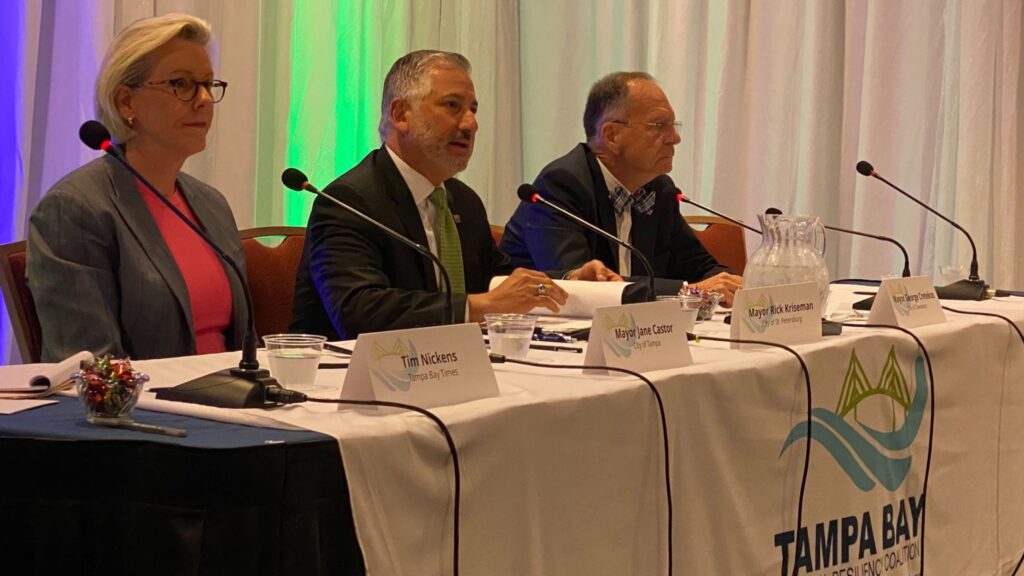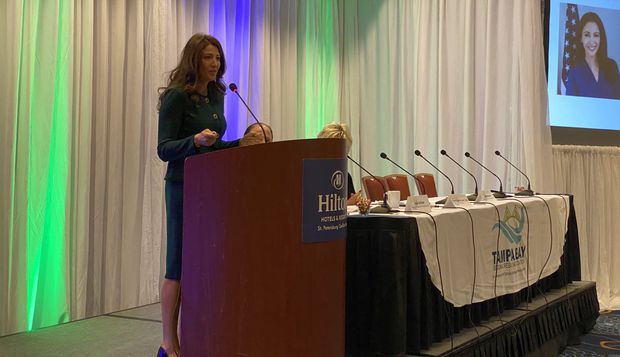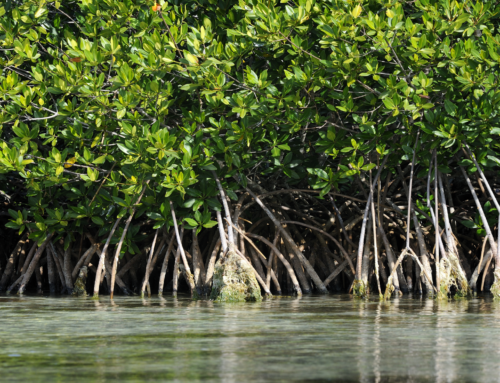The first Tampa Bay Regional Resiliency Coalition Leadership Summit kicked off Tuesday. Local officials were there, and so was Florida’s new Chief Resilience Officer.
From left, Tampa Mayor Jane Castor, St. Petersburg Mayor Rick Kriseman and Clearwater Mayor George Cretekos speak at a summit held by the Tampa Bay Regional Planning Council’s Resiliency Coalition on Tuesday at the Hilton Carillon Park in St. Petersburg. [LANGSTON TAYLOR]
ST. PETERSBURG (Tampa Bay Times) — As she arrived to speak at the region’s first ever resilience leadership summit, Tampa Mayor Jane Castor came upon a hotel parking lot packed with cars.
Hundreds of people from local governments, universities and scientific consulting firms had shown up Tuesday. Valets at the Hilton in Carillon Park double-parked vehicles, choking the entry.
The scene summarized the day: a symbol both of the growing interest in climate change in Tampa Bay and the enormous hurdles officials face as they aim to curb emissions (from cars, for instance) contributing to rising seas.
“We’re coming to the resiliency conference, and there’s a thousand cars out front,” Castor quipped. “Not a good sign.”
For one of the most flood-vulnerable regions in the country, the summit was a starting block — a chance to talk through the challenges all of Tampa Bay faces and is only now starting to take on.
“Nothing that you do will make more difference for our kids and our grandchildren and future generations than the actions that you take here today, and after you leave here today,” said Pinellas County Commissioner Janet Long.
In 2018, the Tampa Bay Regional Planning Council formed its Resiliency Coalition, headed by Long, which organized the event and hopes to shepherd local governments on climate policy.
Among the first speakers was Julia Nesheiwat, Florida’s new chief resilience officer, who made news when she explicitly acknowledged climate change at another workshop in Tampa last year. In Florida, where “I’m not a scientist” was a common refrain of top Republicans over the past decade, her blunt assessment signaled a major policy shift.
“It’s music to my ears to hear, now more than ever, that we are really beyond that point of ‘If there is a problem’ to, ‘What are we really doing about it?’ ” Nesheiwat said Tuesday.
Since last summer, she has toured the state and learned of resiliency projects underway at the local level, such as promoting natural buffers like mangroves and enhancing stormwater infrastructure with pipes and pumps.
Those projects weren’t new to the scientists and longtime planners in the room. What was still notable was hearing climate change discussed by an official from inside the governor’s office.
Nesheiwat said Florida needs to grow jobs in the field of clean energy and look critically at urban centers and planning. That will mean “asking ourselves really difficult questions about whether our current model of growth is indeed sustainable.” That is an unusual statement coming from Tallahassee, which has long catered to the development that helped Florida become the nation’s third most populous state.
“We’re going to have to think really critically about the way our population centers have developed,” Nesheiwat said. Afterward, she explained: “I’m not going to tell folks where to live or not live. At the end of the day, if resilience measures are in place, there could be a balance.”
Julia Nesheiwat, Florida’s chief resilience officer, speaks Tuesday at a summit held by the Tampa Bay Regional Planning Council’s Resiliency Coalition. [LANGSTON TAYLOR]









